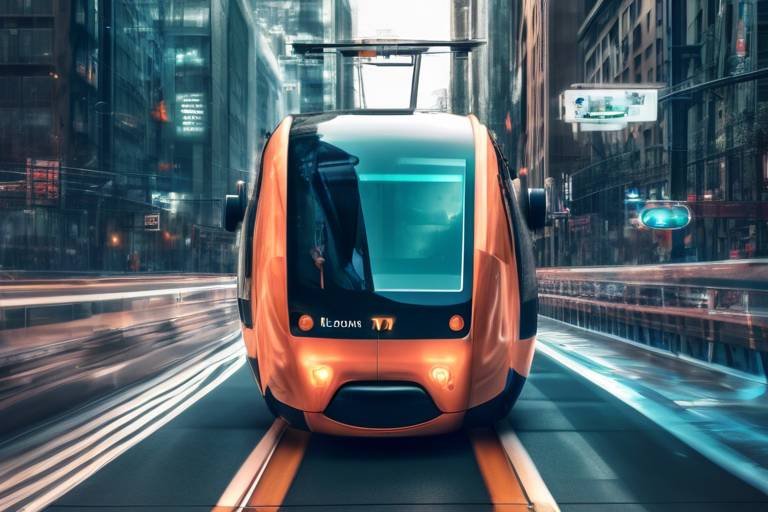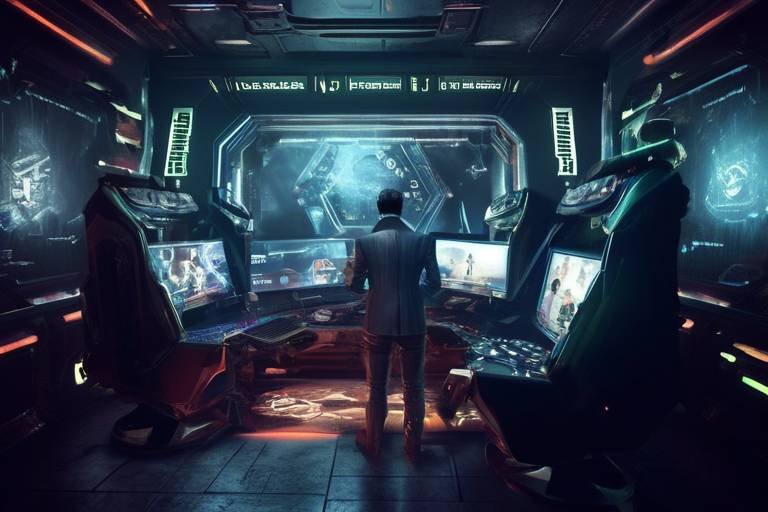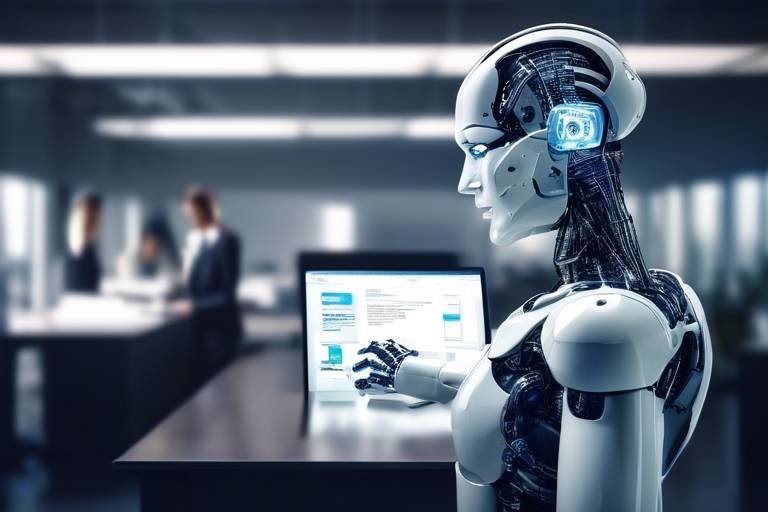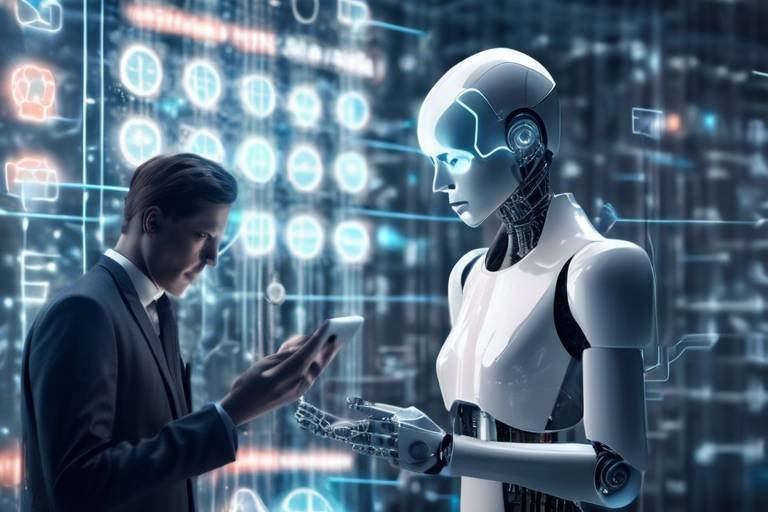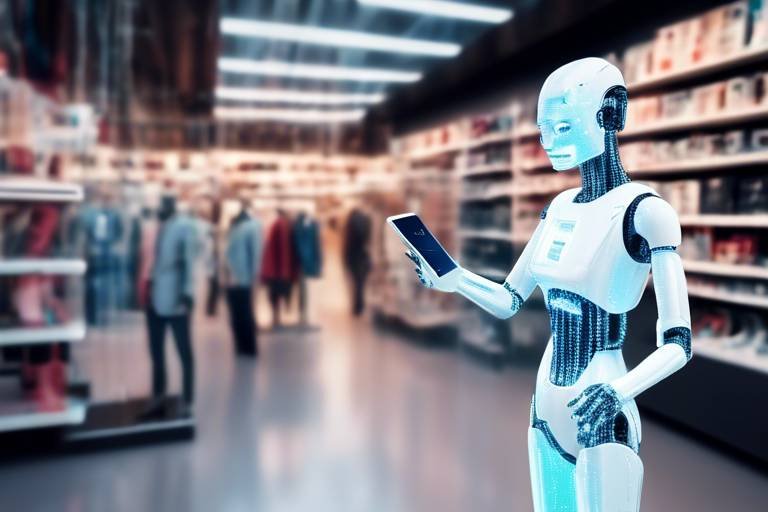AI and the Future of Urban Transportation
As we stand on the brink of a transportation revolution, artificial intelligence (AI) is not just a buzzword; it’s a game changer. The way we move through our cities is evolving at an unprecedented pace, and AI is at the heart of this transformation. Imagine a world where traffic jams are a thing of the past, where public transport is not only efficient but also tailored to your needs. This isn’t science fiction; it’s the future of urban transportation, driven by the power of AI.
Urban areas are becoming increasingly congested, and traditional transportation systems are struggling to keep up with the demands of a growing population. Here’s where AI steps in, offering innovative solutions that enhance efficiency, safety, and sustainability. From autonomous vehicles that promise to revolutionize personal transport to smart traffic management systems that optimize our daily commutes, AI is redefining how we navigate our urban landscapes.
One of the most exciting developments is the rise of autonomous vehicles. These self-driving cars are not just futuristic concepts; they are already being tested and integrated into urban environments. By reducing the number of vehicles on the road and enhancing safety, autonomous vehicles have the potential to significantly decrease traffic congestion. Picture this: you hop into your self-driving car, input your destination, and sit back as the vehicle navigates through the city seamlessly, avoiding traffic hotspots and arriving at your destination stress-free. It’s a vision that is quickly becoming a reality.
But the impact of AI doesn’t stop at personal vehicles. Smart traffic management systems are another critical component of this transformation. These systems leverage AI to analyze real-time data from various sources, including traffic cameras and sensors, to optimize traffic flow. Imagine a city where traffic lights adjust automatically based on current congestion levels, reducing wait times and emissions. This is not just a dream; it’s happening now in cities around the globe.
Moreover, AI is enhancing public transit systems, making them more user-friendly and efficient. With innovations like dynamic routing, buses and trains can adapt to real-time demand, ensuring that services are available where and when they’re needed most. This means no more waiting on a platform for a bus that’s running late; instead, you can rely on a system that adjusts to your needs.
The environmental benefits of AI in urban transportation cannot be overstated. By optimizing routes and promoting the use of electric vehicles, AI contributes to reducing carbon footprints and fostering more sustainable urban environments. Imagine a city where clean air is the norm, and public transport is a viable and attractive option for everyone. This is the sustainable future we are working towards, thanks to the innovations brought about by AI.
In summary, AI is not just changing urban transportation; it’s revolutionizing it. With autonomous vehicles, smart traffic management, and enhanced public transit systems, the future looks bright. As we embrace these technologies, we are paving the way for safer, more efficient, and sustainable urban travel. The journey has just begun, and the possibilities are endless.
- What are autonomous vehicles? Autonomous vehicles are self-driving cars that use AI and sensors to navigate without human intervention.
- How does AI improve traffic management? AI analyzes real-time data to optimize traffic signals and flow, reducing congestion and wait times.
- What is dynamic routing in public transport? Dynamic routing allows public transport to adjust its routes based on real-time passenger demand.
- How does AI contribute to sustainability in transportation? AI optimizes routes and promotes electric vehicles, helping to reduce emissions and improve urban air quality.

The Rise of Autonomous Vehicles
The world is witnessing a revolution in urban transportation, primarily driven by the emergence of autonomous vehicles. These self-driving cars are not just a futuristic concept; they are becoming a reality that promises to reshape our cities and the way we commute. Imagine a world where you can sit back, relax, and let your car do the driving while you catch up on your favorite show or read a book. Sounds appealing, right?
One of the most significant benefits of autonomous vehicles is their potential to reduce traffic congestion. Traditional vehicles often contribute to gridlock, but self-driving cars can communicate with each other and traffic management systems to optimize routes and minimize delays. This synchronization could lead to a significant decrease in the time we spend stuck in traffic, which, let’s be honest, is something we all dream of.
Furthermore, safety is a paramount concern in urban transportation. Autonomous vehicles are equipped with advanced sensors and algorithms designed to detect obstacles, pedestrians, and other vehicles in real-time. This technology allows them to react faster than human drivers, potentially reducing the number of accidents on our roads. According to studies, it is estimated that over 90% of traffic accidents are caused by human error. By removing the human factor, we could see a dramatic decline in these incidents, making our streets safer for everyone.
However, the rise of autonomous vehicles also brings forth a host of challenges that we must address. For instance, the integration of these vehicles into existing infrastructure requires significant investment and innovation. Urban planners and policymakers need to rethink road designs, traffic laws, and even parking systems to accommodate self-driving cars. The transition won't happen overnight, but the potential benefits are too great to ignore.
Moreover, there are societal implications to consider. The advent of autonomous vehicles may lead to job displacement in driving professions, such as taxi drivers and truck operators. However, it also opens up new opportunities in tech development, vehicle maintenance, and urban planning. As we navigate this change, it’s crucial to strike a balance between embracing innovation and ensuring that we support those affected by these shifts.
In summary, the rise of autonomous vehicles is poised to transform urban transportation in ways we are only beginning to understand. Their ability to enhance safety, reduce congestion, and offer a more efficient travel experience makes them a promising solution for the challenges of modern cities. As we look ahead, it’s essential to foster discussions about the implications of this technology, ensuring that we harness its potential for the greater good.

Smart Traffic Management Systems
In the bustling environment of urban areas, managing traffic effectively can feel like trying to solve a complex puzzle with constantly changing pieces. powered by artificial intelligence (AI) are stepping in to transform this chaotic scenario into a more organized and efficient one. By analyzing vast amounts of data in real-time, these systems can optimize traffic flow, minimize wait times, and significantly reduce emissions. Imagine a city where traffic lights adapt based on the actual flow of vehicles rather than a pre-set timer; this is the future that AI promises.
One of the most exciting aspects of smart traffic management is its ability to leverage predictive analytics. By examining historical data and current traffic conditions, AI can forecast congestion patterns, allowing city planners to proactively address potential bottlenecks before they become a major issue. For instance, if data indicates an influx of vehicles due to a local event, traffic signals can be adjusted in advance to accommodate the surge, preventing frustrating gridlock.
Moreover, the integration of real-time traffic monitoring systems plays a crucial role in enhancing urban mobility. These systems provide instant updates regarding traffic conditions, accidents, and road closures. Drivers can receive alerts through their navigation apps, enabling them to reroute and avoid delays. This not only saves time but also contributes to a smoother traffic experience across the city. The synergy between AI and real-time data creates a dynamic environment where both commuters and authorities can respond swiftly to changing conditions.
Furthermore, as cities strive to become smart cities, the integration of AI in traffic management aligns perfectly with broader initiatives aimed at improving urban living. Smart traffic systems don't just focus on vehicles; they also consider pedestrian and cyclist safety. For example, traffic signals can be programmed to prioritize pedestrian crossings during peak walking times, ensuring that everyone can navigate the city safely.
In summary, the implementation of smart traffic management systems is a game-changer for urban transportation. By utilizing predictive analytics and real-time monitoring, these systems enhance traffic flow, improve safety, and contribute to a more sustainable environment. As cities continue to evolve, the role of AI in traffic management will undoubtedly grow, paving the way for smarter, more efficient urban landscapes.
- What is a smart traffic management system?
A smart traffic management system uses AI and real-time data to optimize traffic flow, reduce congestion, and enhance road safety. - How does predictive analytics improve traffic management?
Predictive analytics analyzes historical and current data to forecast traffic patterns, enabling cities to implement proactive measures to prevent congestion. - Can smart traffic systems help reduce emissions?
Yes, by optimizing traffic flow and reducing idle times, smart traffic systems can significantly lower vehicle emissions, contributing to cleaner air.

Predictive Analytics in Traffic Flow
Predictive analytics is a game changer in the realm of urban transportation. It’s like having a crystal ball that allows city planners and traffic management systems to foresee potential traffic jams before they happen. By utilizing a combination of historical data and real-time information, predictive analytics can accurately forecast traffic patterns, enabling cities to take proactive measures. Imagine a bustling city during rush hour; without predictive analytics, it’s a chaotic scene of honking horns and frustrated drivers. But with the right data at hand, cities can implement strategies to alleviate congestion and enhance the overall flow of traffic.
One of the most significant benefits of predictive analytics is its ability to identify trends and patterns in traffic behavior. For example, by analyzing data from various sources such as GPS, traffic cameras, and social media, predictive models can determine when and where traffic is likely to build up. This allows for timely interventions, such as adjusting traffic signal timings or deploying additional public transport options. It’s akin to a conductor leading an orchestra, ensuring that every vehicle plays its part harmoniously in the grand symphony of urban mobility.
Moreover, predictive analytics doesn't just help in managing existing traffic; it also plays a crucial role in long-term infrastructure planning. City planners can utilize these insights to make informed decisions about where to build new roads, expand public transport routes, or even develop bike lanes. This data-driven approach ensures that cities can adapt to the evolving needs of their populations while minimizing disruptions. Here’s a quick breakdown of how predictive analytics enhances traffic flow:
- Forecasting Traffic Patterns: By analyzing historical traffic data, cities can predict peak times and adjust traffic management strategies accordingly.
- Resource Allocation: Identifying areas prone to congestion allows for better allocation of resources, such as traffic officers or road maintenance crews.
- Emergency Response: Real-time data helps authorities respond quickly to accidents and road closures, rerouting traffic to minimize delays.
In conclusion, predictive analytics serves as a vital tool in modern urban transportation systems. By harnessing the power of data, cities can not only improve the efficiency of their traffic flow but also enhance the safety and satisfaction of their residents. As we move forward into an era where technology and urban living intertwine, predictive analytics will undoubtedly play a pivotal role in shaping the future of our cities.
- What is predictive analytics in traffic flow? Predictive analytics in traffic flow refers to the use of historical and real-time data to forecast traffic patterns, allowing for proactive measures in traffic management.
- How does predictive analytics improve traffic management? By identifying potential congestion points and adjusting traffic signals accordingly, predictive analytics helps to optimize traffic flow and reduce wait times.
- Can predictive analytics help reduce accidents? Yes, by providing real-time updates and forecasts, predictive analytics can help authorities respond more quickly to accidents, thereby reducing the likelihood of secondary incidents.

Data-Driven Decision Making
In the fast-paced world of urban transportation, has emerged as a critical strategy for city planners and policymakers. Imagine trying to navigate a bustling city without a map—chaotic, right? That's precisely what urban planners face when they lack access to comprehensive data. By leveraging data analytics, cities can pinpoint traffic bottlenecks, identify accident-prone areas, and understand commuter behavior. This wealth of information allows for informed decisions that enhance the efficiency and safety of urban transport systems.
Data-driven decision making isn't just about collecting numbers; it's about transforming those numbers into actionable insights. For instance, consider a city that experiences frequent traffic jams during rush hour. By analyzing traffic patterns, planners can implement measures such as adjusting traffic light timings or introducing new bus routes to alleviate congestion. This proactive approach not only improves traffic flow but also enhances the overall travel experience for residents. In essence, data becomes the compass guiding urban transportation strategies.
Moreover, the integration of real-time data is revolutionizing how cities respond to transportation challenges. With the advent of smart sensors and connected devices, urban areas can monitor traffic conditions in real-time. This information can be disseminated to commuters via mobile apps, allowing them to choose alternative routes or modes of transport. Imagine receiving an alert on your phone that suggests taking a different route due to an accident ahead—saving you precious time and reducing frustration. This dynamic feedback loop fosters a more responsive transportation ecosystem.
Another fascinating aspect of data-driven decision making is its role in resource allocation. Cities can utilize data analytics to determine where to invest in infrastructure improvements. For example, if data reveals that a particular intersection has a high incidence of accidents, planners can prioritize safety enhancements, such as better signage or traffic calming measures, in that area. This targeted approach ensures that resources are used effectively, maximizing the impact of every dollar spent.
Furthermore, the collaboration between various stakeholders—government agencies, private companies, and the community—is essential in fostering a culture of data-driven decision making. By sharing data and insights, these parties can work together to tackle urban transportation challenges holistically. For instance, public transit authorities can collaborate with tech companies to develop innovative solutions that meet the needs of commuters. This synergy not only enhances transportation systems but also builds trust within the community.
In conclusion, data-driven decision making is reshaping urban transportation by providing the tools necessary for informed planning and responsive action. As cities continue to evolve, harnessing the power of data will be crucial in creating efficient, safe, and sustainable transportation networks. The future of urban mobility is bright, and it all starts with the data at our fingertips.
- What is data-driven decision making in urban transportation? It refers to the process of using data analytics to inform planning and operational decisions in transportation systems.
- How does real-time data impact urban transportation? Real-time data allows cities to monitor traffic conditions, enabling quick responses to incidents and improving overall traffic flow.
- Why is collaboration important in data-driven decision making? Collaboration among stakeholders ensures that data is shared effectively, leading to more comprehensive solutions to urban transportation challenges.

Real-Time Traffic Monitoring
Imagine driving through a bustling city, where every stoplight, every intersection, and every traffic jam is being watched over by an invisible guardian—this is the essence of . This technology utilizes a network of sensors, cameras, and AI algorithms to provide instantaneous updates on traffic conditions, allowing both drivers and city authorities to react swiftly to changing scenarios. With the integration of these advanced systems, urban transportation is becoming not only more efficient but also significantly safer.
Real-time traffic monitoring systems collect data from various sources, including GPS signals from vehicles, traffic cameras, and even social media reports. This wealth of information is then processed to offer a comprehensive view of the current traffic landscape. For instance, if an accident occurs on a major thoroughfare, the system can quickly alert drivers through mobile apps or roadside signs, suggesting alternate routes to avoid congestion. This kind of proactive communication is crucial in minimizing delays and enhancing overall travel experience.
Moreover, the data gathered isn't just useful in the moment; it also feeds into predictive models that help city planners make informed decisions about infrastructure improvements. For example, if a particular intersection consistently shows high congestion levels during rush hour, city officials can use this information to consider adding turn lanes or adjusting traffic signal timing. Ultimately, this creates a ripple effect that leads to smoother traffic flow and reduced frustration for commuters.
In addition to improving traffic flow, real-time monitoring systems also play a pivotal role in enhancing safety. By providing immediate alerts about accidents or hazardous conditions, these systems help prevent further incidents. For example, if a vehicle breaks down in a busy lane, the system can notify nearby drivers and emergency services, ensuring that help arrives quickly while also warning others to slow down and navigate carefully around the situation.
To illustrate the impact of real-time traffic monitoring, consider the following table showcasing key benefits:
| Benefit | Description |
|---|---|
| Improved Response Times | Authorities can react swiftly to accidents or traffic jams, minimizing disruption. |
| Enhanced Safety | Immediate alerts reduce the likelihood of secondary accidents. |
| Data-Driven Decisions | City planners can utilize traffic data for future infrastructure projects. |
| Increased Efficiency | Real-time updates help drivers choose optimal routes, reducing travel time. |
In summary, real-time traffic monitoring is a game-changer for urban transportation. It not only makes our roads safer and more efficient but also empowers city planners to create a better infrastructure for the future. As technology continues to evolve, we can expect these systems to become even more sophisticated, further enhancing our day-to-day travel experiences.
- What is real-time traffic monitoring?
Real-time traffic monitoring involves using sensors, cameras, and AI to provide live updates on traffic conditions, helping to manage flow and enhance safety. - How does real-time traffic monitoring improve safety?
By providing immediate alerts about accidents and hazardous conditions, it helps prevent further incidents and ensures that emergency services can respond quickly. - Can real-time traffic data influence city planning?
Absolutely! The data collected can inform city planners about congestion patterns, allowing them to make data-driven decisions for infrastructure improvements.

Integration with Smart City Technologies
As we dive into the realm of urban transportation, the integration of artificial intelligence with smart city technologies is becoming a game-changer. Imagine a city where everything is interconnected, where traffic lights communicate with vehicles, and public transport systems adapt in real-time to the needs of commuters. This is not just a futuristic dream; it’s happening right now! By leveraging AI, urban planners and city officials can create an efficient, responsive transportation network that enhances the quality of life for all residents.
One of the most exciting aspects of this integration is the potential for seamless travel experiences. With AI analyzing data from various sources—like traffic cameras, GPS, and public transport schedules—city dwellers can receive real-time updates and recommendations. For instance, if a bus is running late, the system can notify passengers and suggest alternative routes or modes of transport. This level of connectivity not only reduces frustration but also encourages more people to use public transportation, knowing they have reliable information at their fingertips.
Additionally, the integration of AI in smart cities can lead to significant improvements in traffic management. By utilizing machine learning algorithms, cities can predict traffic patterns and adjust signals accordingly to optimize flow. This dynamic adjustment reduces congestion and minimizes travel times, ultimately leading to a more sustainable urban environment. For example, during peak hours, traffic lights can be programmed to stay green longer for busy intersections, while less-traveled routes receive shorter wait times. This kind of intelligent traffic control can significantly enhance the overall efficiency of urban mobility.
To illustrate the potential impact of AI integration, consider the following table that outlines key benefits:
| Benefit | Description |
|---|---|
| Enhanced Connectivity | AI enables different transportation modes to communicate, providing users with real-time updates and options. |
| Improved Efficiency | Traffic management systems optimize flow, reducing congestion and travel time. |
| Data-Driven Insights | City planners can make informed decisions based on predictive analytics, leading to better infrastructure development. |
| Sustainability | Encourages the use of public transport and reduces reliance on personal vehicles, lowering emissions. |
Moreover, the integration of AI with smart city technologies fosters a sense of community. As residents engage with these systems—be it through apps that provide transportation updates or platforms that allow for feedback on services—they feel more connected to their city. This participatory approach not only improves services but also empowers citizens to be active contributors to the development of their urban environment.
In conclusion, the integration of AI into urban transportation systems is paving the way for smarter, more efficient cities. As we embrace these technologies, we’re not just improving transportation; we’re enhancing the very fabric of urban life. The future holds endless possibilities, and with AI at the helm, we can look forward to a transportation experience that is not only functional but also enjoyable.

Enhancing Public Transit Systems
Public transportation has long been the backbone of urban mobility, but with the infusion of artificial intelligence, it is undergoing a remarkable transformation. Imagine a world where buses and trains are not only punctual but also adapt dynamically to the needs of commuters. AI technologies are making this dream a reality, enhancing the efficiency and user-friendliness of public transit systems. From dynamic routing to improved scheduling, these innovations are designed to better serve the diverse needs of urban dwellers.
One of the most exciting advancements in public transit is the concept of dynamic routing. This technology enables transit systems to adjust their routes in real-time based on passenger demand. For instance, if a particular bus route experiences an unexpected surge in passengers, AI can quickly recalibrate the route to accommodate this influx. This not only reduces wait times but also enhances the overall user experience. Think of it as having a personal chauffeur who knows exactly where you need to go and how to get there efficiently!
Moreover, AI is revolutionizing scheduling in public transit. Traditional schedules can often be rigid, leading to inefficiencies and frustration for commuters. However, with AI-driven scheduling, transit authorities can analyze real-time data and adjust their schedules accordingly. This means that during peak hours, more buses or trains can be deployed, while during quieter times, resources can be allocated more efficiently. The result? A smoother, more reliable transit experience that meets the demands of city dwellers.
Furthermore, enhancing accessibility and inclusivity is another critical aspect of AI in public transit. AI-driven solutions are being developed to ensure that public transportation caters to the needs of all individuals, including those with disabilities. For example, smart apps can provide real-time updates on accessibility features at transit stations, such as elevators or ramps, ensuring that everyone can navigate the system with ease. This not only fosters a sense of community but also ensures that no one is left behind in the quest for efficient urban mobility.
To illustrate the impact of AI on public transit systems, consider the following table that highlights key benefits:
| Benefit | Description |
|---|---|
| Increased Efficiency | Real-time data analysis allows for better resource allocation and scheduling. |
| Improved User Experience | Dynamic routing reduces wait times and optimizes travel paths for commuters. |
| Enhanced Accessibility | AI solutions ensure that public transit meets the needs of all users, including those with disabilities. |
| Environmental Sustainability | Optimized routes lead to reduced emissions and promote greener urban transport options. |
As we look to the future, it’s clear that AI is not just a tool; it’s a game-changer for public transit systems. With these innovations, cities can expect a more connected, efficient, and inclusive transportation network that not only meets the current demands of urban life but also anticipates future needs. The integration of AI into public transit is paving the way for a more sustainable and user-friendly urban environment.
- How does AI improve public transit? AI enhances public transit by optimizing routes, improving scheduling, and ensuring accessibility for all users.
- What is dynamic routing? Dynamic routing is a system that adjusts transit routes in real-time based on passenger demand.
- Are AI solutions accessible for people with disabilities? Yes, AI technologies are designed to improve accessibility by providing real-time updates on transit features.
- What are the environmental benefits of AI in transit? AI helps reduce emissions by optimizing traffic flow and encouraging the use of sustainable transport options.

Dynamic Routing for Buses and Trains
This article explores how artificial intelligence is transforming urban transportation systems, enhancing efficiency, safety, and sustainability. We will examine various aspects, including autonomous vehicles, traffic management, and public transit innovations.
Autonomous vehicles are reshaping urban landscapes by reducing traffic congestion and providing safer transportation options. Their integration into the transport system promises to revolutionize how we navigate cities.
AI-powered traffic management systems optimize traffic flow, reducing wait times and emissions. These systems analyze real-time data to adjust traffic signals and improve overall urban mobility.
Predictive analytics uses historical and real-time data to forecast traffic patterns, allowing cities to implement proactive measures for congestion management and infrastructure planning.
Data-driven decision-making enhances urban transportation by enabling city planners to identify problem areas and allocate resources effectively for improved traffic conditions.
Real-time traffic monitoring systems provide instant updates on congestion and accidents, allowing drivers and authorities to respond quickly and efficiently to changing conditions.
Integrating AI in urban transportation systems aligns with smart city initiatives, enhancing connectivity and creating a seamless travel experience for residents and visitors alike.
AI technologies are modernizing public transit systems, making them more efficient and user-friendly. Innovations include dynamic routing and improved scheduling to better serve commuters.
Dynamic routing is a game-changer for public transportation, especially for buses and trains. Imagine a transit system that can adapt in real-time to the needs of its users. This technology utilizes AI algorithms to analyze passenger demand, traffic conditions, and other variables to determine the most efficient routes. The beauty of dynamic routing lies in its flexibility; instead of sticking to a rigid schedule that may not reflect actual demand, buses and trains can adjust their paths based on real-time data.
For instance, during peak hours, if a bus route is seeing a surge in passengers, the system can reroute additional buses to that area, reducing wait times and preventing overcrowding. Conversely, during off-peak hours, the system can optimize routes to save fuel and resources, ensuring that vehicles aren't running empty. This adaptive approach not only enhances the commuter experience but also contributes to operational efficiency.
Furthermore, dynamic routing can significantly impact urban planning. City officials can use data generated from these systems to identify trends in public transport usage, leading to informed decisions about where to build new transit lines or improve existing routes. The potential benefits are vast:
- Reduced wait times: Passengers spend less time waiting for transit options.
- Increased efficiency: Resources are allocated based on actual demand.
- Enhanced user experience: Commuters enjoy a more tailored travel experience.
As cities continue to grow, the demand for efficient public transit will only increase. Dynamic routing is not just a technological advancement; it’s a necessary evolution in urban transportation that aligns with the needs of modern commuters.
Q: What is dynamic routing?
A: Dynamic routing allows public transportation systems to adjust their routes in real-time based on passenger demand and traffic conditions.
Q: How does AI improve public transit?
A: AI enhances public transit by optimizing routes, improving scheduling, and providing real-time updates, making transportation more efficient and user-friendly.
Q: What are the benefits of AI in urban transportation?
A: The benefits include reduced traffic congestion, improved safety, lower emissions, and a more sustainable urban environment.

Improving Accessibility and Inclusivity
In today's world, ensuring that everyone has access to reliable transportation is not just a luxury; it's a necessity. AI-driven solutions are paving the way for a more inclusive public transportation system, allowing individuals with disabilities and other mobility challenges to navigate urban environments with ease. Imagine a city where public transit is as accessible as your favorite app—this is the future we are striving for!
One of the most significant advancements in this area is the development of smart mobility apps that provide real-time information tailored to individual needs. For example, these apps can offer features like audio descriptions for visually impaired users or route suggestions that avoid stairs for those with limited mobility. By integrating these technologies, public transit can become a friendlier space for all passengers.
Furthermore, AI is enhancing the physical infrastructure of public transportation. Automatic doors, wheelchair ramps, and priority seating are becoming standard in many transit systems, thanks to data-driven insights that highlight the necessity for such features. This is not just about compliance with regulations; it's about creating an environment where everyone feels welcome and valued.
Moreover, the implementation of dynamic routing systems allows public transport vehicles to adjust their routes based on real-time demand. This means that if a bus is frequently used by individuals with disabilities at certain times, it can be scheduled more often during those hours. Such adaptability ensures that all community members have reliable transport options, reducing wait times and enhancing the overall user experience.
To further illustrate how AI is improving accessibility, consider the following table that outlines some key features of AI-driven public transit solutions:
| Feature | Description |
|---|---|
| Smart Mobility Apps | Real-time updates and personalized route planning for users with disabilities. |
| Dynamic Routing | Adjusts routes based on demand, ensuring timely service for all users. |
| Infrastructure Improvements | Automatic doors and ramps enhance physical access to public transport. |
| Feedback Systems | Collects user feedback to continually improve accessibility features. |
In conclusion, the integration of AI technologies in public transportation is not just a trend—it's a transformative movement towards greater accessibility and inclusivity. By prioritizing the needs of all individuals, we are not only enhancing the user experience but also fostering a sense of community where everyone can participate in urban life. As we move forward, it is crucial that city planners and transportation authorities continue to innovate and adapt, ensuring that no one is left behind.
- How is AI improving public transit for individuals with disabilities?
AI enhances public transit by providing real-time information, improving infrastructure, and enabling dynamic routing tailored to user needs. - What are smart mobility apps?
These are applications that offer personalized transportation solutions, including route suggestions and real-time updates for users with specific accessibility needs. - Why is accessibility in public transportation important?
Accessibility ensures that all individuals, regardless of their physical abilities, can navigate urban environments, promoting inclusivity and independence.

Environmental Impact of AI in Transportation
As we continue to grapple with the pressing issues of climate change and urban pollution, the role of artificial intelligence in transforming transportation is more crucial than ever. AI technologies are stepping up to the plate, offering innovative solutions that not only enhance efficiency but also significantly reduce the environmental footprint of urban transport systems. Imagine a city where traffic jams are a thing of the past, and the air is cleaner and fresher. This vision is becoming a reality, thanks to the integration of AI in our transportation networks.
One of the most significant ways AI contributes to environmental sustainability is through route optimization. By analyzing vast amounts of data, AI can determine the most efficient paths for vehicles to take, minimizing unnecessary travel and reducing fuel consumption. This not only saves time but also leads to a substantial decrease in greenhouse gas emissions. For instance, studies suggest that optimized routing can reduce emissions by up to 30% in congested urban areas. That's a staggering number when you consider the cumulative effect across an entire city!
Moreover, AI plays a pivotal role in promoting the use of electric vehicles (EVs). With the rise of smart charging stations and real-time energy management systems, AI can help manage when and where EVs are charged, ensuring that they are powered by renewable energy sources whenever possible. This shift not only supports the reduction of fossil fuel dependency but also encourages the growth of a cleaner energy infrastructure. The following table illustrates the potential impact of AI on electric vehicle adoption:
| Impact Area | Before AI Integration | After AI Integration |
|---|---|---|
| Average Emissions (g CO2/km) | 180 | 90 |
| Electric Vehicle Adoption Rate (%) | 5 | 25 |
| Reduction in Traffic Congestion (%) | 10 | 40 |
In addition to these advancements, AI is also encouraging the development of sustainable mobility solutions. Services like car-sharing and bike-sharing are gaining traction, thanks to AI-driven platforms that match users with available vehicles or bikes in real time. This not only reduces the number of cars on the road but also promotes a culture of shared mobility, which is essential for sustainable urban living. Think of it as a communal effort towards greener cities, where we all play a part in reducing our carbon footprints.
Furthermore, AI technologies are enhancing public transportation systems, making them more efficient and accessible. By improving scheduling and routing, AI ensures that public transit is a viable option for more people, thereby reducing reliance on personal vehicles. This shift is crucial, as public transit typically produces fewer emissions per passenger compared to private cars. The environmental benefits of increased public transit usage cannot be overstated, as it leads to fewer cars on the road and, consequently, lower overall emissions.
As we look to the future, the integration of AI in urban transportation systems holds the promise of not just smarter cities but also a healthier planet. The potential for sustainability through AI is immense, and the journey has only just begun. With ongoing advancements and a collective commitment to embracing these technologies, we can pave the way for a cleaner, greener future in our urban landscapes.
- How does AI reduce emissions in urban transportation?
AI reduces emissions by optimizing traffic flow, improving route efficiency, and promoting electric vehicle usage. - What role do electric vehicles play in sustainable transportation?
Electric vehicles contribute to sustainability by reducing reliance on fossil fuels and lowering greenhouse gas emissions. - Can AI improve public transportation systems?
Yes, AI enhances public transportation by optimizing scheduling, routing, and making services more accessible to a broader audience. - What are some examples of sustainable mobility solutions?
Examples include car-sharing, bike-sharing, and on-demand shuttle services that reduce the number of vehicles on the road.

Reducing Emissions through Optimization
In today's rapidly urbanizing world, the quest for sustainable transportation solutions has never been more pressing. One of the most effective strategies to combat the growing issue of urban pollution is through optimization. By leveraging advanced algorithms and data analytics, AI systems can significantly reduce emissions from vehicles, making our cities cleaner and healthier places to live. Imagine a bustling city where traffic flows smoothly, and the air is noticeably fresher—this is not just a dream but a reality that AI can help create.
At the heart of this optimization process is the ability to analyze real-time traffic data. AI systems can monitor traffic patterns, identify congestion points, and suggest alternative routes for vehicles. For instance, when a major intersection is congested, the system can reroute traffic to less busy streets, thereby reducing idling time and minimizing fuel consumption. This not only cuts down on emissions but also saves drivers precious time. According to recent studies, cities that have implemented AI-driven traffic management systems have seen emissions decrease by up to 30% in heavily trafficked areas.
Moreover, AI can optimize the performance of electric and hybrid vehicles, ensuring they operate at peak efficiency. By analyzing factors such as battery charge levels, route topography, and driving behavior, these systems can provide recommendations that enhance energy use. For example, when a driver approaches a steep hill, the AI can suggest switching to a more energy-efficient driving mode, which in turn reduces energy consumption and lowers emissions.
In addition to optimizing individual vehicle performance, AI can also facilitate the integration of sustainable transport solutions into urban environments. For example, cities can implement smart public transport systems that adjust their schedules and routes based on real-time passenger demand. This not only encourages more people to use public transport—thereby reducing the number of cars on the road—but also optimizes the use of electric buses and trains, further lowering overall emissions.
To illustrate the impact of these optimizations, consider the following table that highlights the potential reductions in emissions across various transportation modes when AI is utilized:
| Transportation Mode | Emission Reduction Potential (%) |
|---|---|
| Personal Vehicles | 20-30% |
| Public Transit (Buses/Trains) | 25-35% |
| Electric Vehicles | 15-25% |
| Car-Sharing Programs | 30-40% |
As we move towards a more sustainable future, the role of AI in optimizing emissions cannot be overstated. By employing these technologies, cities can not only enhance the efficiency of their transportation systems but also contribute significantly to global climate goals. The road ahead is paved with opportunities, and with the right tools, we can transform urban transportation into a cleaner, greener, and more efficient system.
- How does AI reduce emissions in urban transportation?
AI reduces emissions by optimizing traffic flow, improving vehicle performance, and promoting the use of electric and public transport solutions. - What are some examples of AI applications in transportation?
Examples include smart traffic management systems, dynamic routing for public transit, and real-time monitoring of traffic conditions. - Can AI help in reducing traffic congestion?
Yes, AI can analyze traffic patterns and adjust signals and routes to alleviate congestion, making travel more efficient. - What is the impact of electric vehicles on urban emissions?
Electric vehicles produce zero tailpipe emissions, and when combined with AI optimization, their overall impact on urban air quality can be significantly positive.

Encouraging Sustainable Mobility Solutions
As cities continue to expand and populations grow, the demand for efficient and environmentally friendly transportation options becomes increasingly critical. AI is at the forefront of this transformation, actively encouraging sustainable mobility solutions that not only reduce our carbon footprint but also enhance the overall quality of urban life. One of the most promising trends is the rise of car-sharing and bike-sharing programs, which are becoming essential components of modern urban transportation. These services allow residents to access vehicles or bicycles on an as-needed basis, significantly reducing the number of cars on the road and, consequently, traffic congestion.
Imagine a city where you can effortlessly hop on a bike or a shared electric vehicle to reach your destination without the hassle of parking or maintenance. This is not just a dream; it's a reality that AI is helping to create. By analyzing patterns in user behavior and traffic flow, AI systems can optimize the placement of shared vehicles, ensuring they are readily available where and when they are needed most. This not only enhances convenience for users but also promotes a culture of shared mobility, reducing the reliance on personal vehicles.
Moreover, AI plays a crucial role in the implementation of smart routing algorithms that guide users to the most efficient modes of transport. For instance, if a user requests a ride, the AI can suggest the fastest route while considering real-time traffic data, weather conditions, and even the availability of public transport options. This holistic approach not only saves time but also encourages individuals to consider alternatives to driving alone.
In addition to car and bike-sharing, public transit systems are also evolving to incorporate sustainable practices. AI technologies enable transit authorities to analyze ridership data, allowing for more effective scheduling and route planning. This means that buses and trains can be deployed more efficiently, reducing wait times and making public transport a more attractive option for commuters. The integration of electric and hybrid vehicles into public transit fleets further enhances sustainability, as these vehicles produce significantly lower emissions compared to traditional diesel buses.
As we embrace these innovations, it's essential to consider the broader impact on our communities. Encouraging sustainable mobility solutions not only addresses environmental concerns but also fosters social equity. By making transportation more accessible and affordable, we can ensure that everyone, regardless of their economic status, has the opportunity to participate in urban life fully. This is particularly important in densely populated areas where transportation options have historically been limited.
In conclusion, the role of AI in promoting sustainable mobility solutions is not just about technology; it's about reimagining how we move within our cities. By leveraging data and intelligent systems, we can create a future where transportation is efficient, eco-friendly, and inclusive. As we stand on the brink of this transportation revolution, the question remains: are we ready to embrace the change?
- What are sustainable mobility solutions? Sustainable mobility solutions refer to transportation options that minimize environmental impact, such as car-sharing, bike-sharing, and the use of electric vehicles.
- How does AI improve public transportation? AI improves public transportation by optimizing routes, analyzing ridership data, and enhancing scheduling to better meet the needs of commuters.
- Why is shared mobility important? Shared mobility reduces the number of vehicles on the road, decreases traffic congestion, and lowers greenhouse gas emissions, contributing to a healthier urban environment.
- What role do smart technologies play in urban transportation? Smart technologies, powered by AI, enable real-time data analysis and decision-making, leading to more efficient and responsive transportation systems.
Frequently Asked Questions
- What are autonomous vehicles and how do they work?
Autonomous vehicles, or self-driving cars, use a combination of sensors, cameras, and artificial intelligence to navigate without human intervention. They analyze their surroundings in real-time, making decisions based on data to ensure safe and efficient travel. Imagine a car that can see, think, and react like a human driver but does it all with pinpoint accuracy!
- How does AI improve traffic management in cities?
AI enhances traffic management by utilizing real-time data to optimize traffic signals and flow. It reduces congestion and wait times, making commutes smoother. Picture a traffic system that can adapt instantly to the number of cars on the road, like a conductor guiding an orchestra for perfect harmony!
- What role does predictive analytics play in urban transportation?
Predictive analytics leverages historical and current traffic data to forecast patterns and trends. By anticipating congestion, cities can proactively implement solutions, ensuring a seamless travel experience. Think of it as having a crystal ball that helps city planners foresee traffic jams before they happen!
- How does AI enhance public transit systems?
AI modernizes public transit through dynamic routing and improved scheduling, allowing services to adapt to real-time passenger demand. This means fewer delays and more efficient travel options. It’s like having a personal assistant for your commute, always ensuring you get where you need to go on time!
- In what ways does AI contribute to environmental sustainability in transportation?
AI helps reduce carbon footprints by optimizing routes and promoting electric vehicle usage. By minimizing emissions, it plays a crucial role in improving urban air quality and supporting climate goals. Imagine a cleaner, greener city where every ride contributes to a healthier planet!
- How can AI improve accessibility in public transportation?
AI-driven solutions focus on making public transportation more inclusive by catering to the needs of individuals with disabilities. This includes features like real-time updates and tailored services, ensuring everyone can travel comfortably. It’s like rolling out the red carpet for all commuters, making sure no one is left behind!

